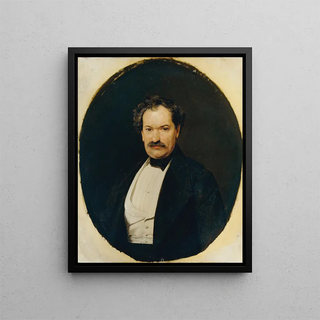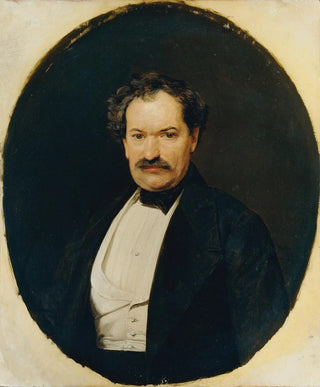Art print | Man in a black coat with a white vest - Ferdinand Georg Waldmüller


View from behind

Frame (optional)
In the fascinating world of 19th-century art, the art print "Man in a black coat with a white vest" by Ferdinand Georg Waldmüller stands out for its emotional intensity and striking realism. This painting, which captures the very essence of its era, invites us to delve into the world of portraits where the psychology of the characters is highlighted. Through the penetrating gaze of the subject, the artist offers us a window into a time marked by social and cultural upheavals. Every detail of this work, from the folds of the black coat to the reflections on the white vest, demonstrates exceptional craftsmanship and artistic sensitivity that transcends time.
Style and uniqueness of the work
Waldmüller, an emblematic figure of Austrian realism, manages to combine impeccable technique with a deeply human approach. In "Man in a black coat with a white vest," light plays a fundamental role, illuminating the face of the subject while creating an atmosphere of mystery. The choice of colors, dominated by dark tones highlighted with light touches, emphasizes the contrast between the individual and their environment. This art print is characterized by meticulous attention to detail, each fold of the clothing, each facial expression being carefully rendered. Waldmüller does not merely depict a man; he captures a personality, an essence. This portrait, while rooted in its time, evokes universal emotions that still resonate today, making this piece a truly timeless masterpiece.
The artist and his influence
Ferdinand Georg Waldmüller, born in 1793 in Vienna, is often considered one of the pioneers of realism in painting. Trained in the tumultuous context of artistic revolutions, he managed to establish himself with his unique style that favors faithful representation of the world around him. Influenced by the great masters of the past, he also succeeded in integrating elements of daily life, making his works accessible and close to the concerns of his time. Waldmüller had a significant impact on the artistic scene of his era, inspiring many artists to explore similar themes.

Matte finish

View from behind

Frame (optional)
In the fascinating world of 19th-century art, the art print "Man in a black coat with a white vest" by Ferdinand Georg Waldmüller stands out for its emotional intensity and striking realism. This painting, which captures the very essence of its era, invites us to delve into the world of portraits where the psychology of the characters is highlighted. Through the penetrating gaze of the subject, the artist offers us a window into a time marked by social and cultural upheavals. Every detail of this work, from the folds of the black coat to the reflections on the white vest, demonstrates exceptional craftsmanship and artistic sensitivity that transcends time.
Style and uniqueness of the work
Waldmüller, an emblematic figure of Austrian realism, manages to combine impeccable technique with a deeply human approach. In "Man in a black coat with a white vest," light plays a fundamental role, illuminating the face of the subject while creating an atmosphere of mystery. The choice of colors, dominated by dark tones highlighted with light touches, emphasizes the contrast between the individual and their environment. This art print is characterized by meticulous attention to detail, each fold of the clothing, each facial expression being carefully rendered. Waldmüller does not merely depict a man; he captures a personality, an essence. This portrait, while rooted in its time, evokes universal emotions that still resonate today, making this piece a truly timeless masterpiece.
The artist and his influence
Ferdinand Georg Waldmüller, born in 1793 in Vienna, is often considered one of the pioneers of realism in painting. Trained in the tumultuous context of artistic revolutions, he managed to establish himself with his unique style that favors faithful representation of the world around him. Influenced by the great masters of the past, he also succeeded in integrating elements of daily life, making his works accessible and close to the concerns of his time. Waldmüller had a significant impact on the artistic scene of his era, inspiring many artists to explore similar themes.






